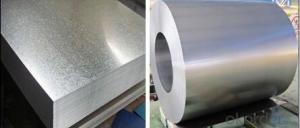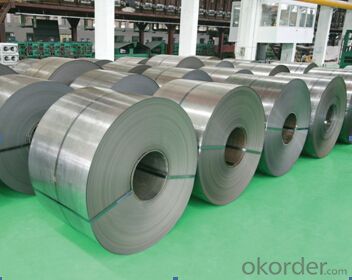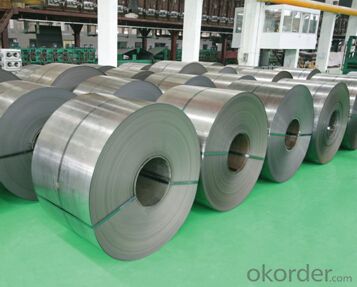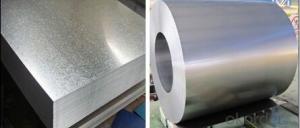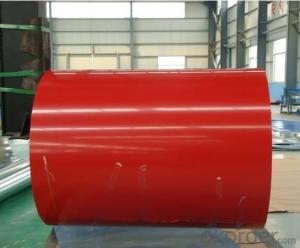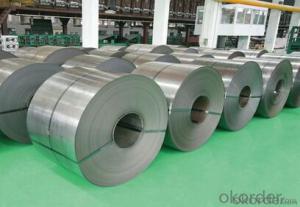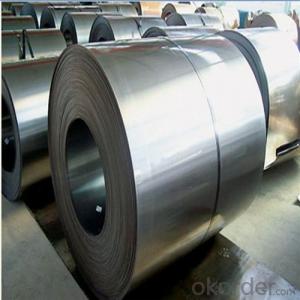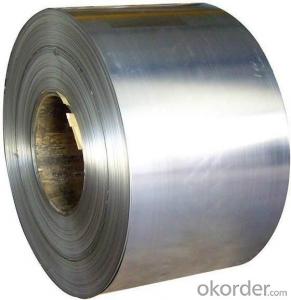Cold Rolled Steel Descriptions for Your needs
- Loading Port:
- China main port
- Payment Terms:
- TT OR LC
- Min Order Qty:
- 30 m.t.
- Supply Capability:
- 100000 m.t./month
OKorder Service Pledge
OKorder Financial Service
You Might Also Like
1.Structure of Cold Rolled Steel Description:
The raw material of cold rolled steel coil/sheet is high quality hot rolled product, and after pickling continuous rolling, degreasing, annealing,skin pass,slitting and cut to length line etc. Along with it many kinds of new technology and new process of global cold rolling production have been applied. Therefore the quality of the goods could be guaranteed. The product is widely used in outdoor and interior decoration, furnishing manufacturing, home appliance, automobile etc.
2.Main Features of the Cold Rolled Steel:
• Excellent process capability
• Smooth and flat surface
• Workability, durability
• Excellent heat resistance performance
• High strength
• Good formability
• Good visual effect
3.Cold Rolled Steel Images
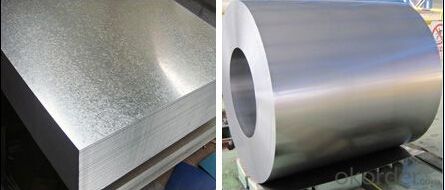
4.Cold Rolled Steel Specification
Standard:AISI,ASTM,DIN,GB,JIS,JIS G3302 ASTM 653M EN10142
Grade: Q195~Q345
Thickness: 0.16mm~1.5mm,0.16-1.5mm
Width: 1250,600-1250mm
Coil weight:3-12 MT
Coil ID:508/610mm
Chemical composition:
C | Si | Mn | Cr | Ni | P | S |
0.150 | 0.476 | 11.231 | 12.50 | 0.900 | 0.039 | 0.010
|
5.FAQ of Cold Rolled Steel
We have organized several common questions for our clients,may help you sincerely:
1.How about your company?
A world class manufacturer & supplier of castings forging in carbon steel and alloy steel,is one of the large-scale professional investment casting production bases in China,consisting of both casting foundry forging and machining factory. Annually more than 8000 tons Precision casting and forging parts are exported to markets in Europe,America and Japan. OEM casting and forging service available according to customer’s requirements.
2.How to guarantee the quality of the products?
We have established the international advanced quality management system,every link from raw material to final product we have strict quality test;We resolutely put an end to unqualified products flowing into the market. At the same time, we will provide necessary follow-up service assurance.
3. How long can we receive the product after purchase?
Usually within thirty working days after receiving buyer’s advance payment or LC. We will arrange the factory manufacturing as soon as possible. The cargo readiness usually takes 15-25 days, but the shipment will depend on the vessel situation.
- Q: What are the common methods of forming steel coils?
- There are several common methods for forming steel coils, each with its own unique advantages and applications. The most common method is known as hot rolling. This involves heating a large steel slab to a high temperature and passing it through a series of rollers to reduce its thickness. The steel is then coiled into a large, continuous roll. Hot rolling is typically used for producing steel coils with a consistent thickness and a smooth surface finish. It is commonly used in industries such as automotive, construction, and manufacturing. Another method is cold rolling, which is similar to hot rolling but is performed at room temperature. Cold rolling involves passing the steel through a set of rollers to further reduce its thickness and improve its surface finish. This process is often used to produce steel coils with precise dimensions and excellent mechanical properties. Cold-rolled steel coils are commonly used in applications that require high strength, such as in the production of appliances, electrical components, and structural components. A third method is known as galvanizing. This involves coating the steel coil with a layer of zinc to protect it from corrosion. The steel coil is first cleaned and then immersed in a bath of molten zinc. The zinc adheres to the surface of the steel, forming a protective layer. Galvanized steel coils are widely used in outdoor applications, such as roofing, fencing, and automotive parts, due to their excellent corrosion resistance. Lastly, there is the electro-galvanizing method. This process involves applying a thin layer of zinc to the surface of the steel coil through an electroplating process. The steel coil is immersed in an electrolyte solution and an electric current is passed through it, causing the zinc to deposit onto the surface of the steel. Electro-galvanized steel coils are commonly used in industries that require a smooth and aesthetically pleasing finish, such as in the production of appliances, automotive parts, and decorative items. Overall, these common methods of forming steel coils provide a wide range of options for different applications and requirements. Whether it is hot rolling, cold rolling, galvanizing, or electro-galvanizing, each method offers unique benefits in terms of strength, durability, surface finish, and corrosion resistance.
- Q: How are steel coils processed and treated?
- Steel coils are processed and treated through a series of steps to ensure their quality and suitability for various applications. The process begins with uncoiling the steel coil, which involves removing the outer layers of protective wrapping and unwinding the coil. Once uncoiled, the steel is inspected for any defects, such as cracks or uneven surfaces. Next, the steel coil goes through a cleaning process to remove any dirt, oil, or rust present on its surface. This is typically done using a combination of chemical cleaning agents and mechanical scrubbing. After cleaning, the coil is rinsed and dried to prevent any residual moisture from causing corrosion. Once cleaned, the steel coil can undergo various treatments depending on its intended use. One common treatment is pickling, which involves immersing the coil in an acidic solution to remove impurities and scale. This process helps to improve the surface finish and prepares the steel for further processing. After pickling, the coil may be subjected to cold rolling, a process that reduces its thickness and improves its dimensional accuracy. Cold rolling involves passing the steel through a series of rollers at room temperature, gradually reducing its thickness and increasing its strength. This process also improves the surface finish of the steel coil. In some cases, the steel coil may undergo additional heat treatment processes, such as annealing or tempering. Annealing involves heating the coil to a specific temperature and then slowly cooling it, which helps to relieve internal stresses and improve its mechanical properties. Tempering, on the other hand, involves reheating the coil to a lower temperature and then cooling it rapidly. This process enhances the strength and toughness of the steel. Once the desired processing and treatments are complete, the steel coil may be coated or painted to provide additional protection against corrosion or to enhance its aesthetic appearance. Coating processes can include hot-dip galvanizing, electroplating, or applying organic coatings such as paint or powder coatings. Finally, the processed and treated steel coils are typically cut into specific sizes or shapes based on customer requirements. This can be done using various cutting methods such as shearing, slitting, or sawing. Overall, the processing and treatment of steel coils involve a combination of cleaning, pickling, rolling, heat treatment, coating, and cutting processes. These steps are carefully carried out to ensure the quality, strength, and suitability of the steel for its intended applications.
- Q: How are steel coils protected against moisture and humidity?
- Steel coils are protected against moisture and humidity through a variety of methods. One common method is the application of a protective coating on the surface of the steel. This coating acts as a barrier, preventing moisture from coming into direct contact with the steel surface. Coatings can be made of various materials such as paint, zinc, or other corrosion-resistant substances. In addition to coatings, steel coils are often wrapped in a moisture-resistant material such as plastic or waxed paper. This wrapping provides an extra layer of protection, preventing moisture from seeping into the coils during storage or transportation. Furthermore, steel coils are typically stored in a controlled environment with controlled humidity levels. This helps to minimize the chances of moisture condensation on the surface of the coils. Storage facilities may also utilize dehumidifiers or other moisture control measures to maintain optimal conditions. Lastly, proper handling and transportation practices are crucial in ensuring the protection of steel coils against moisture and humidity. Special care is taken to avoid exposing the coils to rain or excessive humidity during loading, unloading, and transportation processes. By employing these various protective measures, steel coils can be effectively safeguarded against moisture and humidity, reducing the risk of corrosion and maintaining their quality and integrity.
- Q: How are steel coils used in the production of agricultural storage tanks?
- Steel coils are used in the production of agricultural storage tanks as they serve as the primary material for constructing the tank walls and base. The coils are shaped and welded together to form a sturdy and durable structure that can withstand the weight and pressure of storing agricultural products such as grains, feed, and fertilizers. The steel coils provide the necessary strength and corrosion resistance required for long-term storage in various agricultural environments.
- Q: What is the average size of a steel coil?
- The average size of a steel coil can vary depending on the specific application and industry. However, in general, steel coils typically have a width ranging from 600mm to 2000mm and a weight between 2 to 25 metric tons.
- Q: How are steel coils used in the manufacturing of construction equipment?
- Steel coils are used in the manufacturing of construction equipment as they provide a strong and durable material for various components. These coils are shaped and processed into different parts, such as frames, chassis, and reinforcements, which enhance the structural integrity and overall performance of construction machinery.
- Q: I am planning to buy a Walther P22. I have liked the Pistol's performance-superb.The only confusion that I have is about the Polymer Frame.Just for this I may shift to someother manufacturer.Are Polymer Frames better than Steel in durability and lifespan.Walther says YES.Any comments on this...Practical users...Thanks in advance
- All polymer frames are cast around steel 'skeleton' inserts, which bear the stress and wear between receiver slide, as well as other wear points. The great advantage to polymer frames is the lower weight over the polymer composite compared to an all-steel or other metal alloy receiver frame. As all wear contact points are 'steel-to-steel', the service life expectancy of a polymer-frame weapon will be the same as an all-steel frame design. NO polymer-frame design I know of has ANY stress or load contact points between metal and polymer-only surfaces. My polymer-frame H-K USP and my Glocks are constructed this way.
- Q: What are the common storage defects in steel coils?
- Steel coils can suffer from various storage defects, including staining or discoloration, rust or corrosion, coil deformation, surface damage, edge damage, coil slippage, contamination, and coil nesting. These defects can negatively impact the appearance, quality, usability, and safety of the steel. To prevent these defects, it is essential to implement proper handling, storage, and protection measures. This involves storing the steel coils in a dry and well-ventilated area, away from moisture and chemicals. Additionally, appropriate stacking and support structures should be used to prevent deformation and bending. To avoid mishandling and transport damage, it is important to stack and handle the coils correctly. Adequate protection against impacts and contaminants should be provided to prevent surface scratches, dents, and abrasions, as well as edge damage. It is crucial to ensure that the edges of the coils are properly protected and secured during storage to maintain their usability and safety. Furthermore, to prevent coil slippage and potential harm to personnel or equipment, the steel coils should be securely stored and stacked. To avoid contamination, the coils should be kept away from substances like dirt, oil, grease, and chemicals. Regular inspections and maintenance should be conducted to identify and address any potential defects or issues promptly. Overall, by implementing these proper handling, storage, and protection measures, the occurrence of these common storage defects in steel coils can be minimized, ensuring the appearance, quality, usability, and safety of the steel.
- Q: haii, i have this guitar thats quite old and im not quite sure whether to put steel strings on it. there were very thin badly worn steel strings on it when i got it, so i think its an acoustic
- That's a very low-end Kay, maybe from the 60's or 70's. It has a weird mixture of steel-string and classical features that you often see in cheap imports from around that time, maybe because the factory didn't want to stock different parts for different lines. The tuners (one of which is missing) are made for steel strings. They will work with nylon but not well. The bridge is a generally classical type but appears to be bolted on and seems to have some compensation carved into the saddle, which indicates it may have been intended for steel strings. Probably it's ladder braced, which is not a great design for either type. It has a classical rosette and a steel-string pickguard. I am guessing the neck has steel reinforcement but unless there's a sticker there's no way to tell. Personally I'd put light or (preferably) extra-light steel strings on it. The short scale length will help keep the tension down. I'd keep an eye on the neck though. You could also try silk steel to be on the safe side, but the bass response will probably be lacking.
- Q: How are steel coils distributed globally?
- Steel coils are distributed globally through a well-established supply chain network. Manufacturers typically ship steel coils to various locations worldwide through ocean freight or rail transportation. These coils are then distributed to customers, including construction companies, automotive manufacturers, and other industries, through local distributors or directly from steel service centers. Additionally, international trade and partnerships play a significant role in the global distribution of steel coils, ensuring a steady supply to meet market demands.
Send your message to us
Cold Rolled Steel Descriptions for Your needs
- Loading Port:
- China main port
- Payment Terms:
- TT OR LC
- Min Order Qty:
- 30 m.t.
- Supply Capability:
- 100000 m.t./month
OKorder Service Pledge
OKorder Financial Service
Similar products
Hot products
Hot Searches
Related keywords
